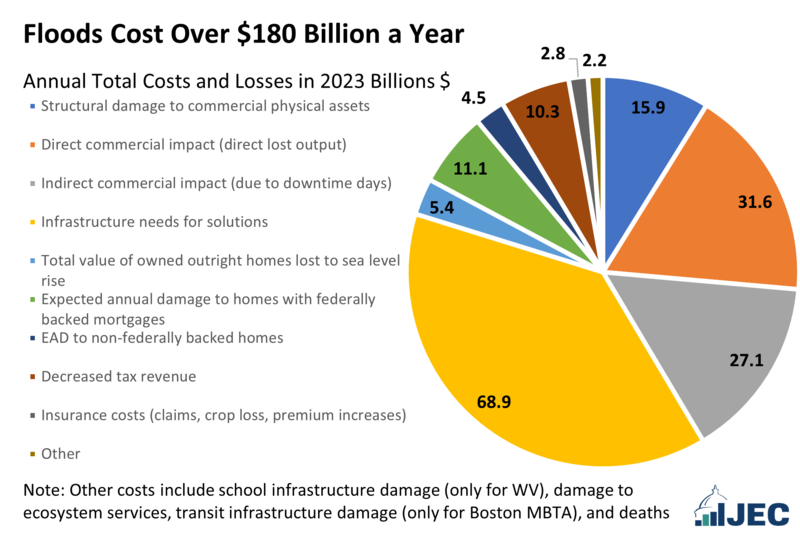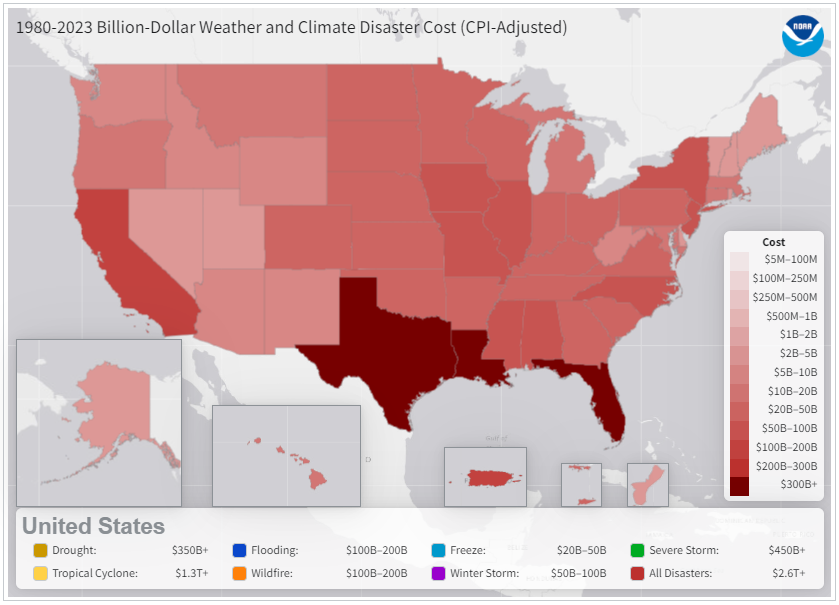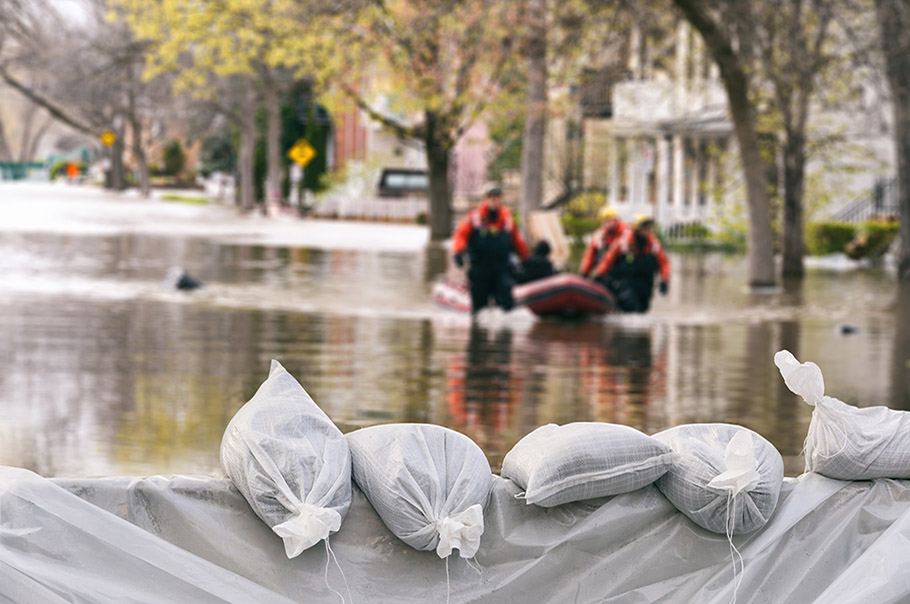According to new data from Democrats on the Senate Joint Economic Committee, flooding cost the U.S. economy an estimated $179.8 to $496 billion in 2023.
As the climate continues to change, the frequency and severity of extreme weather events, including flooding, are on the rise. These natural disasters not only pose immediate threats to life and property but also have been shown to have profound and lasting impacts on the economy. Understanding these risks and their economic implications is crucial for businesses, governments, and individuals alike.
The Growing Threat of Flooding
Flooding is one of the most common and destructive natural disasters. It can be caused by a variety of factors, including heavy rainfall, storm surges, and the overflow of rivers and dams. Climate change exacerbates these risks by increasing the intensity of storms and altering precipitation patterns, leading to more frequent and severe floods.
Climate change could displace Americans by not only rising sea levels, intensifying wildfires, and causing floods, but also by making insurance coverage prohibitively expensive. In states such as California, Florida, and Louisiana, many homeowners are finding it nearly impossible to secure insurance coverage for their properties. Meanwhile, a surge of new policyholders is joining state-backed insurance “plans of last resort,” leaving states to assume more risk on behalf of residents who can’t find private sector coverage, particularly as flooding risks increase, according to Stateline.
Industry leaders highlight that insurance companies have been overwhelmed by substantial payouts. Last year alone, 28 distinct natural disasters in the U.S. each caused at least $1 billion in damage, according to federal data. Consequently, insurers say that they cannot afford to offer coverage in the highest-risk areas.
Economic Impacts of Flooding
According to Axios, between about $70 billion and $345 billion in infrastructure upgrades are needed for flood protection. And on top of that, up to $40 billion a year is needed for direct commercial impacts from flooding and up to $10.8 billion a year is estimated to represent the total value of owned homes lost to sea level rise. The numbers are staggering. The economic impact comes in several forms, in addition to insurance, as well:
Infrastructure Damage: Floods can cause extensive damage to infrastructure such as roads, bridges, and power lines. The cost of repairing and rebuilding this infrastructure can run into billions of dollars, straining public resources and delaying other critical projects.
Property and Crop Losses: Homes, businesses, and agricultural lands are often the hardest hit by flooding. Property damage can lead to significant financial losses for homeowners and businesses, while crop losses can affect food supply chains and increase prices.
Disruption of Business Operations: Flooding can disrupt business operations by damaging facilities, cutting off supply chains, and displacing employees. This disruption can lead to a loss of revenue and increased operational costs as businesses struggle to recover.
Public Health: Floodwaters can contaminate drinking water supplies and spread waterborne diseases, leading to increased healthcare costs and reduced productivity as people fall ill.

Extreme Weather and Economic Stability
Beyond flooding, other forms of extreme weather such as hurricanes, heatwaves, and droughts also pose significant economic risks. These events can lead to similar economic disruptions, including damage to infrastructure, agricultural losses, and increased health care costs. Additionally, extreme weather can lead to energy shortages, as seen during heatwaves when demand for electricity spikes, causing blackouts and increasing operational costs for businesses. With these increasing risks governments, businesses, and communities are beginning to invest in resilience and adaptation measures such as:
Improving Infrastructure: Building flood defenses, upgrading drainage systems, and constructing resilient infrastructure can help mitigate the damage caused by flooding and other extreme weather events.
Risk Assessment and Planning: Conducting thorough risk assessments and incorporating climate projections into planning and development processes can help identify vulnerabilities and prioritize investments.
Insurance and Financial Instruments: Developing innovative insurance products and financial instruments can help spread the risk and provide a financial safety net for those affected by extreme weather.
Sustainable Practices: Adopting sustainable agricultural and business practices can reduce the vulnerability of key sectors to extreme weather and improve overall resilience.
The Importance of Climate Planning
Businesses and communities across the country are starting to turn to Climate Planning, the terms Risk Planning or Scenario Planning are also used, depending on the source.
Recently, areas of the South were hit with extreme flooding, putting millions at risk of flood damage, power outages, and other threats, and hurricane season hasn’t even started yet. According to Fox News, in the initial five months of 2024, the United States has already incurred $7 billion in costs from disasters, which include storms, heavy snowfall, and higher-than-average temperatures.
In Sarasota County, Florida, for example, they have started a flooding-vulnerability assessment in tandem with the University of Florida’s Institute of Food and Agricultural Sciences. The Assessment will serve as a guide for policymakers to navigate future decisions regarding public works projects and beyond.
Sara Kane, of Sarasota County, told NPR that projects could include stormwater management, green infrastructure projects, planting trees and “doing living shorelines or coastal habitat restoration projects that could reduce flooding and also improve water quality at the same time.” The study is part of a statewide initiative supported by grants from Resilient Florida aimed at mitigating the impacts of climate change. Resilient SRQ secured $201.5 million in federal block grant funding under this program.

The economic impacts of flooding and extreme weather are substantial and widespread. Flooding imposes significant costs on Americans and the economy, which are increasing due to climate change. By investing in flood protection, watershed management, and climate risk planning, both businesses and communities can effectively plan to mitigate its risks.
Weather Source’s Climate Insights products, that range from OnPoint Risk Analytics (Expected Risk) to Climate Change Risk (Possible Risk) and more, provide predictive analyses of climate change scenarios, offering insights into potential impacts on global business operations. These tools empower organizations to strategically adapt and proactively mitigate disruptive threats. Ready to learn more? Contact us to set up a meeting.



